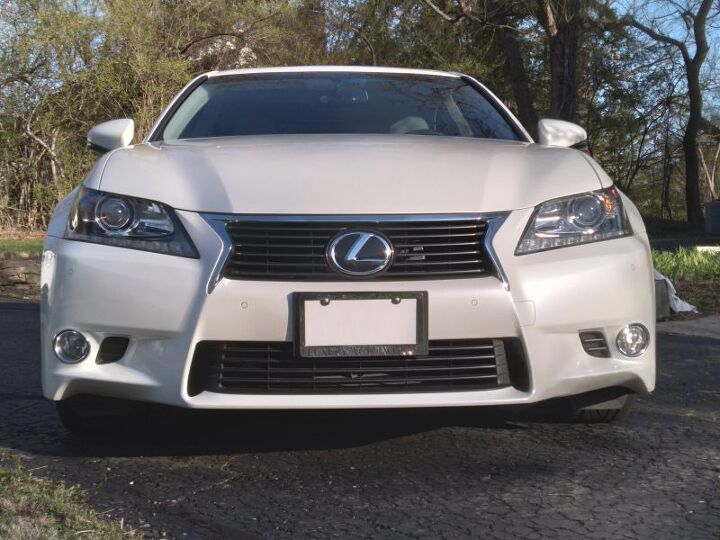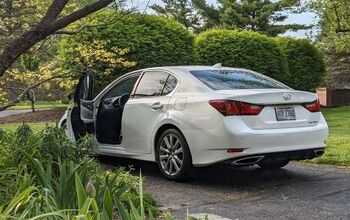Two-year Update: Your Author's 2015 Lexus GS 350

Believe it or not, two full years have passed since I took the very long and fairly rushed journey from Cincinnati to Austin to purchase the 2015 Lexus GS 350. After the fly-then-drive non-holiday trip, it was time to settle into some routine ownership and driving. Routine might be the wrong word though, as within a year the scope of “routine” changed considerably. Want to guess how many miles it’s accumulated over the past couple of years?
Not as many miles as intended, certainly. For most of 2019 I used it for commuting duty on nice days, having decided at purchase I would drive whatever my secondary car was in any rain or snow. Garage car stays clean! For those of you who may be new to TTAC, secondary duty fell first to a Subaru Outback, and at the end of 2019 shifted to a Golf SportWagen. By spring of 2020 with COVID escalating quickly, my workplace shut down entirely and my 25-mile round trip commute transformed into a walk to the home office. Said situation remains the same today, which means driving is largely confined to fun or errand trips. By the way, the odometer on the GS currently reads 44,750, up from the 39,633 listed on the title. At a rate of just over 2,500 miles a year, it’ll round the 100,000-mile mark in 2043.
The driving impressions over my tenure of ownership have remained much the same as they were during the road trip from Austin. The GS is an enjoyable drive on the highway. Wind noise intrusion is kept low via extensive seals everywhere, which I’ve treated with Honda Shin-etsu grease. Seats are comfortable for longer journeys, with enough thigh support (something I’ve found lacking in other vehicles for long journeys, including the Golf.) There’s generally a feeling the speed of travel is lower than it actually is: Traveling at 102 for example doesn’t feel more stressed than 75. Not that I’d ever travel at that speed on a public road, mind you. The audio experience from the Not Levinson stereo system is good, albeit lacking of CarPlay or Android Auto.
Lexus still does not offer that functionality across their line, by the way: GS made it to its 2020 cancellation without those features.
By now I’m used to the Lexus mouse system to use the center screen, but it’s not my favorite. Occasionally overshooting the icon I’m aiming for should be an initial ownership issue, not a persistent one. I’ve found few other gripes on the interior, as pretty much all surfaces are covered with high-quality material that’s padded, stitched, or lined. Squeaks and rattles are nearly non-existent.
A lack of driving meant Lockdown Fun Drives became a staple through the warmer months of 2020, and have returned for 2021. Seeking out roads with curves requires some cartography skill in southwest Ohio, but it’s doable. There, the GS proves a positive, if slightly mixed, bag.
Highlights when you push it include the accurate steering, strong brakes, and a suspension that controls roll well enough to inspire one to push a bit harder. Traction is plentiful from the Continentals, and on public roads it all feels safe and secure.
However, in these Sporting Time driving situations, you feel the heft and width of the GS more acutely. Twisty back roads are generally more narrow, which means enthusiastic driving comes with a “keep far right in the lane” reminder in your mind. The smaller, nimbler Golf is a bit more fun on the same road since it can be thrown around more easily.
Power in everyday driving is more than adequate, but when driving zesty-like on a back road, you’ll wish for 75 more horses or perhaps a turbo to get things moving. The transmission generally finds the right gear in auto mode, and the paddles (which are solid metal) let the driver direct the action further. But no number of held shifts can make up for the fact that it needs more horsepower to feel truly sporty. Guess that’s why the GS F existed (RIP).
Maybe I’m focusing on the S in the GS name a bit too much. Most drivers aren’t going to push it beyond an entrance ramp, and with foot down at the end of a standard one you’ll be moving at three digits. Speaking of S, Sport mode on the central dial changes the gauge background to red, holds shifts longer and makes them sharper, and adds extra induction noise (even if you’re doing 40 miles per hour). The steering gets heavier too, and the throttle more sensitive.
I’ve used Sport on a couple of occasions, but generally leave it in Normal or Eco mode. Sport feels like it’s trying to create a personality via electronics which isn’t actually there. If my mom’s protests (Hi mom!) are any indication, Sport mode is the easiest way to make passengers think you’re being much more aggressive than you actually are. Speaking of passengers, I haven’t heard any comfort complaints, though sitting behind a six-foot driver doesn’t leave a lot of extra legroom in the back. My old M35x was more spacious in the back seat. Rear passengers over six feet will find headroom lacking as well, though that’s perhaps more endemic to sedans in modern times.
In my initial 2019 drive with interstate-only tanks of fuel, I recorded a nice 29.2 miles per gallon. In mixed tanks, that figure has dropped to an average of about 22.5 mpg, depending on how many fun drives the tank contained. Infrequent drives meant months between fill-ups, as seen in the data above.
No matter the economy, I’ve a gripe about the smallish 17.4-gallon fuel tank: In this class of car made for longer-distance cruising, two or three additional gallons of range would not go amiss. As one might expect, I haven’t had any maintenance concerns or repairs. I’ve added air to the tires once, and it’s due for an oil change. Yesterday I received a customer bulletin in the mail about a potential issue with the climate servos failing to deliver air properly, with an extended warranty on that issue in particular through 2022. It affects only some cars apparently, and not something I’ve noticed with mine. I’ll be keeping an eye on it though.
After two years I’m happy with the GS, even if world conditions meant I’ve spent much less time driving it than intended. Current thought on its replacement in let’s say four years or so, an LC 500. You’ll tell me in the comments how that’s a bad choice, I’m sure. Until next time.
[Images © 2021 Corey Lewis / The Truth About Cars]

Interested in lots of cars and their various historical contexts. Started writing articles for TTAC in late 2016, when my first posts were QOTDs. From there I started a few new series like Rare Rides, Buy/Drive/Burn, Abandoned History, and most recently Rare Rides Icons. Operating from a home base in Cincinnati, Ohio, a relative auto journalist dead zone. Many of my articles are prompted by something I'll see on social media that sparks my interest and causes me to research. Finding articles and information from the early days of the internet and beyond that covers the little details lost to time: trim packages, color and wheel choices, interior fabrics. Beyond those, I'm fascinated by automotive industry experiments, both failures and successes. Lately I've taken an interest in AI, and generating "what if" type images for car models long dead. Reincarnating a modern Toyota Paseo, Lincoln Mark IX, or Isuzu Trooper through a text prompt is fun. Fun to post them on Twitter too, and watch people overreact. To that end, the social media I use most is Twitter, @CoreyLewis86. I also contribute pieces for Forbes Wheels and Forbes Home.
More by Corey Lewis
Latest Car Reviews
Read moreLatest Product Reviews
Read moreRecent Comments
- Lorenzo If it's over 30 years old and over 80k miles, and not a classic, it's a parts car, worth no more than 20% of original price.
- Dusterdude No mileage noted on a 33 year old car means likely well north of 300k + miles , along with issues noted , should equate to an ask price of less than $3k
- Ajla IMO, something like this really should be naturally-aspirated.
- Kjhkjlhkjhkljh kljhjkhjklhkjh Unless they are solid state batteries you BAN THEM. I like EVs... but EVs like to burn ... for days
- Kjhkjlhkjhkljh kljhjkhjklhkjh uh .. it looks like a VW golf got the mumps









































Comments
Join the conversation
I had a GS350 F-sport for three days while my 2000 GS400 was in the dealership for repair. It's a lovely car, when I get in it just feels like home so similar in size and proportion to my car. Adequate power to be sure, but it's the quality of the power I didn't like. Compared to my car, it just feels busy, always shifting, always wanting to lunge at a press of the throttle. My old beast just applies big torque and goes, no fuss, not even downshifting (it's only a 5-speed), relaxing speed. I also drove a new ES350 and found it to be a vastly improved car, but it's no GS replacement, there was just something about that GS architecture that clicked for me.
Nice car! I was interested in one of these new in 2016, but there were only two in Canada and I would have had to buy sight-unseen... and more importantly, not driven. There have been very few of these available at Canadian dealers, and not because they are hot sellers. But I did really like the one I test drove in ~2013, and loved my 2001 IS300 (I bought one of the first in Canada!!). No one has ever come close to my Lexus service experience, and I'd love to get another at some point... maybe the LC500. But in 2016, in need of a larger sedan, I ended up buying a much-maligned car on TTAC - a 2016 CTS 3.6 AWD - and I couldn't be happier with the car (not so much with the service experience). My car now only has about 53,000 kms (only ~2500 since January 2020) but remains rattle and squeak free, and still looks and drives like new. My biggest complaint about the car itself is the level of corrosion on steel components under the car, like strut housings - I've never experienced that on any German or Japanese car after only 5 years. CUE had some hiccups in the first few months, but after a couple of updates and a USB port replacement it's been trouble-free and easy to use since. Although I'd prefer knobs, the touch controls on the dash have been very easy to use and very intuitive.